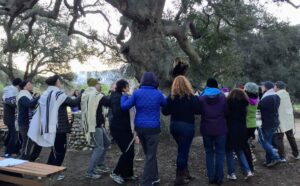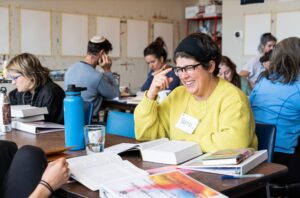Educator professional development initiatives are an integral part of the Jim Joseph Foundation’s strategic philanthropy. Following an open RFP in 2017 to create more professional development opportunities for educators, the Foundation invested in ten new programs. Since that initial investment, the Foundation has commissioned extensive research and evaluation conducted by Rosov Consulting to learn about these specific educator training programs and to more deeply understand other programs across the Foundation’s professional development initiatives portfolio.
Stacie Cherner, Director of Learning and Evaluation at the Jim Joseph Foundation, and Alex Pomson, Principal and Managing Director at Rosov Consulting, shared key learnings in eJewish Philanthropy on designing and measuring high-quality educator training programs. On the Foundation’s blog, Kiva Rabinsky, Chief Program Officer at M²: The Institute for Experiential Jewish Education, shared how learnings from the report influence how M² balances work and play in their design of professional development experiences. And, Robbie Gringras and Abi Dauber Sterne, both formerly of the Jewish Agency for Israel’s Makom, shared how a new Israel education initiative came out of the PDI.
Jim Joseph Foundation Professional Development Initiative
Taking Stock and Offering Thanks: Year 4 Learnings (full report) This report shows that the PDI programs fulfilled their core goals:
- Shared Outcomes Survey data indicate that, overall, the programs helped participants become much more knowledge about and more accomplished in performing the professional tasks for which they are responsible, what we called “ways of thinking and doing.”
- Clinical interview data indicate that these professional outcomes have been quite durable, although with the passage of time interviewees found it increasingly difficult to draw causal links between what they know and can do today and what they gained from their programs.
- Survey data also show that, taken together, the programs have socialized participants into professional communities that the participants very much value. Again, interview data depict how important these communities have been, especially since the start of the pandemic, and how, in the words of one interviewee, “relationships have become partnerships.”
- Finally, survey data reveal the degree to which those program participants who started out with less intensive Jewish backgrounds have had an opportunity to grow and feel more confident as Jewish educators.
A Picture of Learning Coming Together: Year 3 Learnings (full report) This report includes the following sections:
- Design Principles for Powerful Professional Development – Summative Insights
- Participant Audit III: General Findings
- Taking a Journey While Staying at Home: Findings from Year 3 Clinical Interviews
- Consistencies and Subtle Difference: The Shared Outcomes Survey’s Early Promise
- Shared Outcomes Survey: Preliminary Results
Case Studies on Peak Moments of Educator Professional Development Programs
- The SVARA Teaching Kollel: Constructing a ‘Place’ of Learning, Teaching, and Transformation, June 2021
- An Experiment in Learning Two New Languages: JFNA’s Next Gen Jewish Federation Fellowship, January 2021
- Forged by Jewish Historical Experience: The Study of Jewish History as a Crucible for Jewish Professional Learning, October 2020
- Building a Field by Bringing Theory to Practice: M²’s ‘The Architecture of Immersive Experiences, August 2019
- Sheva Center Leadership Institute: A Jim Joseph Foundation Case Study, November 2018
How Educator Professional Development Programs Pivoted During the Pandemic
- Virtually Developing: Exploring the Potential and Pitfalls of Online Professional Development and Adult Learning (executive summary), January 2021
- Virtually Developing: Exploring the Potential and Pitfalls of Online Professional Development and Adult Learning (full report), January 2021
Research Supported by CASJE on the Career Arc of Jewish Educators
- No Going Back to the Future: The Marketplace for Jewish Educators 18 Months in the Covid-19 Pandemic
- An Invitation to Action: Findings and Implications across the Career Trajectories of Jewish Educators Study
- Mapping the Market: An Analysis of the Preparation, Support, and Employment of Jewish Educators
- On the Journey: Compensation – The Salaries and Benefits of Jewish Educators
- On the Journey: Workplace Environments – The Importance of Empowerment, Collegiality, Supervision, and Recognition
- On the Journey: Professional Development for Jewish Educators – Time to Tap Its Potential
- On the Journey: The Journey of Jewish Educators
- Facing the Future: Mapping the Marketplace of Jewish Education during COVID-19
- Preparing For Entry: Concepts That Support a Study of What It Takes to Launch a Career in Jewish Education
- On the Journey: Concepts That Support a Study of the Professional Trajectories of Jewish Educators
 In the past year, more than 10,000 people participated in IJS’s offerings—from online courses on Jewish mindfulness meditation, Tikkun Middot, and prayer as personal practice, to master teachers leading the daily sit, weekly Torah study, and online Yoga studio. IJS also offered specialized training for more than 300 JCC professionals and reached thousands more through its podcast, online retreats, and numerous other programs. These efforts are proven to have positive outcomes. 94 percent of participants in IJS programs say they are more emotionally resilient. And 87 percent of participants say that Jewish spiritual practice deepened their connection with their Jewishness.
In the past year, more than 10,000 people participated in IJS’s offerings—from online courses on Jewish mindfulness meditation, Tikkun Middot, and prayer as personal practice, to master teachers leading the daily sit, weekly Torah study, and online Yoga studio. IJS also offered specialized training for more than 300 JCC professionals and reached thousands more through its podcast, online retreats, and numerous other programs. These efforts are proven to have positive outcomes. 94 percent of participants in IJS programs say they are more emotionally resilient. And 87 percent of participants say that Jewish spiritual practice deepened their connection with their Jewishness.
